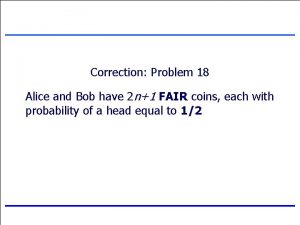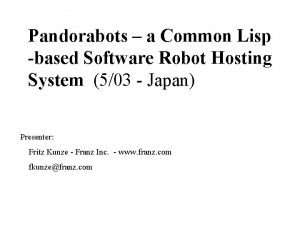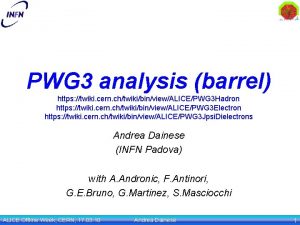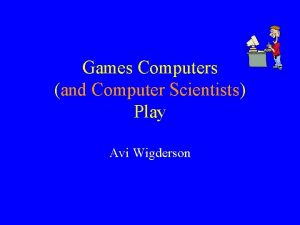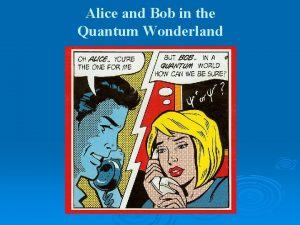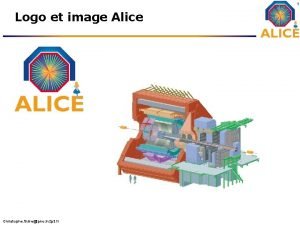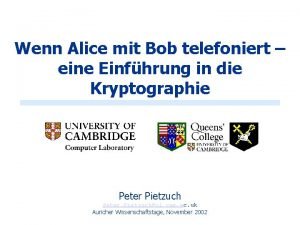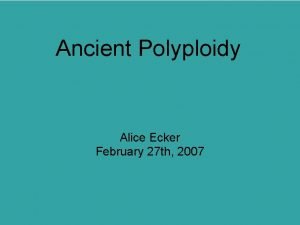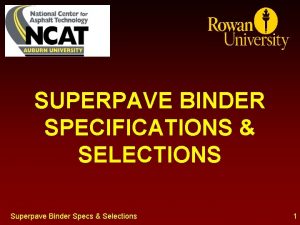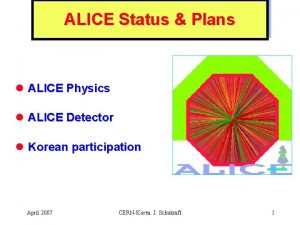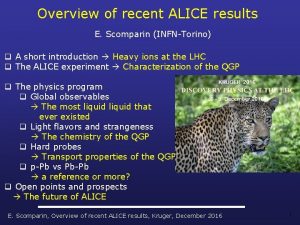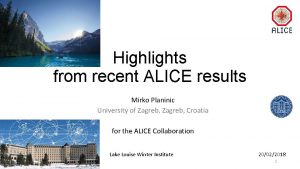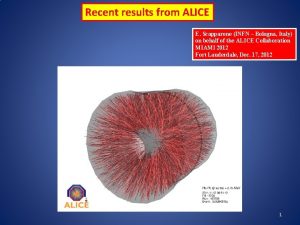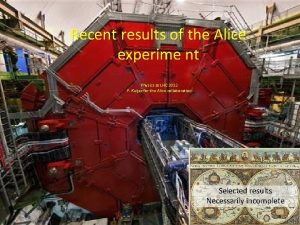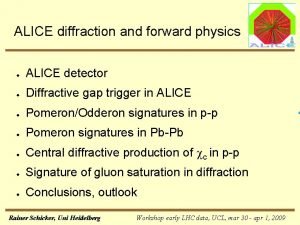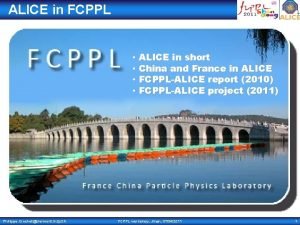Recent ALICE results A selections of recent results








































- Slides: 40

Recent ALICE results A selections of recent results with discussion Marco van Leeuwen Nikhef, Utrecht University for the ALICE collaboration

Time evolution in a heavy ion collision Quark Gluon Plasma/Liquid Strong evidence for (near) thermal equilibrium Pre-equilibrium Freeze-out (post-equilibrium) Expectation: main difference between heavy ion collisions and pp, p+Pb volume + density ⇒ rescattering during evolution ⇒ approach to thermal equilibrium 2

Heavy ion collisions Heavy-ion collisions produce ‘quasi-thermal’ QCD matter Dominated by soft partons p ~ T ~ 100 -300 Me. V ‘Bulk observables’ Study hadrons produced by the QGP Typically p. T < 1 -2 Ge. V Physical model/picture: hydrodynamical flow, thermodynamics ‘Hard probes’ Hard-scatterings produce ‘quasi-free’ partons ⇒Probe medium through energy loss p. T > 5 Ge. V Physical model/picture: hard scattering+parton energy loss Two basic approaches to learn about the QGP 1) Bulk observables 2) Hard probes 3

Intro: collision systems Canonical thinking ‘Recent’ developments pp Observation: Flow-like long range correlations Hard scattering + ‘Underlying event’ p+Pb p p Suggested mechanisms: • Multi-parton interactions • Color reconnection Pb Observation: Flow-like long range correlations p pp-like plus Cold Nuclear Matter effects Pb+Pb Bulk dynamics described by hydrodynamics + Hard Probes • Multi-parton interactions • Color reconnection • Color Glass Condensate Pb Pb Physical picture holds But some features also seen in high-multiplicity p+Pb and pp? 4

Intro: LHC and ALICE LHC, Geneva 2010 -2013: Run 1 pp @ 7, 8 Te. V p+Pb @ 5. 02 Te. V Pb+Pb @ 2. 76 Te. V Run 2 started 2015 pp @ 13 Te. V Pb+Pb @ 5. 02 Te. V ALICE: general purpose detector Focus on • Tracking in high-multiplicity events • Particle identification • Forward muon detector for quarkonia p+Pb @ 8 Te. V in 2016 or 2018 5

Multiplicity d. Nch/dη in pp, Pb+Pb PLB 753, 319 First results from Run-2: multiplicity at new energies Trend continues to rise faster for AA than pp: conversion of energy to particles in AA is more efficient (larger ‘stopping’) 6

Multiplicity vs centrality Pb. Pb ar. Xiv: 1509. 07299 Centrality dependence very similar at 5. 02 and 2. 76 Te. V (overall factor 1. 2) Driven by geometry No change in contribution hard vs soft processes Model comparisons: Soft physics models agree Hijing: some deviations 7

Radial and elliptic flow ALICE, PLB 736, 196 Spectra change from pp to Pb+Pb: • Increase in mean p. T • Larger effect for larger mass First indication of collective behaviour Pressure leads to radial flow Same Lorentz boost (β) gives larger momentum for heavier particles (mp > m. K > mπ ) 8

Mean p. T overview pp QM 15 talk, L Bianchi Mean p. T in pp collisions also increases with multiplicity and particle mass Multiple (initial state) interactions or proto-flow? Or are they the same? Logarithmic fit ‘to guide the eye’: 9

Mean p. T overview pp, p+Pb, Pb+Pb QM 15 talk, A Ortiz Increasing mean p. T trend continues in p+Pb Raises question: is there flow, collective behaviour in pp, p+Pb? And how is it generated? 10

Elliptic flow R ea ct io n pl an e Hydrodynamical calculation Elliptic flow: Yield modulation in-out reaction plane ϕ reaction plane b Anisotropy reduces during evolution v 2 more sensitive to early times 11

Elliptic flow JHEP 106, 190 Mass-dependence of v 2 measures flow velocity Measurements include 8 particle species Tests hydrodynamical description, freeze-out models 12

Higher harmonics N. Mohammadi, QM 2015 Alver and Roland, PRC 81, 054905 Odd harmonics driven by initial state fluctuations 3 rd harmonic ‘triangularity’ v 3 is large (in central events) Mass ordering also seen for v 3 indicates collective flow Use multiple harmonics to constrain medium properties (viscosity) and initial state 13

trigger Near side associated 2 -particle correlations PLB 708, 249 Intermediate p. T High p. T Pb+Pb Near-side peak: jets (+decays): larger at high p. T Flow v 2, v 3: long range correlation (early times+ long expansion) Near side long range correlation: flow (v 2, v 3) Most prominent at lower p. T Away-side: recoil jet also gives a long-range correlation (η 1 ≠ η 2) 14

2 -particle correlations in p+Pb Pb+Pb ALICE, PLB 719, 29 Peripheral p+Pb Central p+Pb Near-side long range correlation in central p+Pb Must be early-time; looks like elliptic flow 15

v 2 from di-hadron correlations in p+Pb PLB 726, 164 Similar ‘mass ordering’ observed for v 2 from two-particle correlations in p+Pb Is this also pressure-driven? 16

Higher p. T: probes of the QGP ‘Hard probes’ Hard-scatterings produce ‘quasi-free’ partons ⇒Probe medium through energy loss p. T > 5 Ge. V 17

Nuclear modification: Pb+Pb Charged particle p. T spectra ALICE, PLB 720, 52 CMS, EPJC, 72, 1945 ATLAS, ar. Xiv: 1504. 04337 Nuclear modification factor Low p. T: soft production, Npart scaling Energy loss Ncoll: number of binary nucleon-nucleon collisions RAA < 1 Pb+Pb: clear suppression (RAA < 1): parton energy loss 18

RAA overview ALICE: PLB 720, 52; EPJ. C 74, 3054 CMS: http: //arxiv. org/abs/1410. 4825 (Z 0) EPJ. C 72, 1945; PLB 710, 256; PLB 715, 66 RAA < 1 for hadrons: Parton energy loss Hadrons: energy loss RAA < 1 γ : no interactions RAA = 1 RAA ≈ 1 for �� , Z, W: No energy loss for electromagnetic and weak probes p+Pb: Rp. Pb ≈ 1 at high p. T No/very small ‘cold nuclear matter’ effects on high-p. T probes 19

RAA vs models ‘Analytical models’ Burke et al, JET Collaboration, ar. Xiv: 1312. 5003 HT-BW Several formalisms/approximations for parton energy loss exist Allows to determine medium properties, transport coefficient Monte Carlo event generators JEWEL: MC event generator with parton energy loss Based on analytical formalism 1 parameter: medium density tuned to data Zapp, JHEP 1303, 80 20

Heavy flavour RAA; mass dependence ALICE, JHEP 11, 205 Compare charm: D-mesons beauty: non-prompt J/Ψ Larger suppression for charm than for beauty Agrees with expected ‘dead-cone effect’ energy loss reduced when v < c Indicates radiative energy loss: induced gluon bremmsstrahlung 21

Jets: reconstructing the partons Goal: measure energy loss distributions - Longitudinal (fragmentation function) - Transverse (jet profiles ϕ Qualitatively two scenarios: 1) In-cone radiation: RAA = 1, change of fragmentation 2) Out-of-cone radiation: RAA < 1 η 22

Jet RAA ALICE, PLB 746, 1 Jet suppression (R = 0. 2) similar to charged particle suppression Suppression/out-of-cone radiation reasonably well described by energy-loss Monte Carlo models Large effect of out-of-cone radiation (R=0. 2) 23

Jet shapes Measure particle distribution inside jets on a jet-by-jet basis Radial moment (girth) p. T-dispersion p. T-weighted jet width (Normalised) spread of p. T Anti-correlated with multiplicity Large range of jet shape variables can be explored So far, focused on two: 1 transverse, 1 longitudinal 24

Jet shapes: radial moment QM talk, Cunqueiro Radial moment smaller in Pb+Pb than pp (PYTHIA) JEWEL model shows similar trend Jets in medium narrower than in vacuum 25

Jet shapes: p. T, D QM talk, Cunqueiro p. T, D slightly larger in Pb+Pb than pp (PYTHIA) JEWEL model shows similar trend Larger p. T, D: smaller multiplicity and/or harder fragment distribution 26

Direct photons ar. Xiv: 1509. 07324 Main expected sources: • High p. T: hard scattering; quark-gluon Compton process • Low p. T: thermal radiation Excess at low p. T in central collisions indicates thermal photon production 27

Summary Soft particle production • Flow: sensitive to initial state geometry and medium properties • Exploring pp, p+Pb as a function of multiplicity • Flow-like effects observed • Thermalisation in small systems? What is the mechanism? High p. T: Hard probes • Large nuclear modification: parton energy loss • Exploring jets, jet shapes to map out radiation, validate understanding of dynamics Many topics not covered due to time: J/Ψ production (quark coalescence), femtoscopy: map source size and final state interactions, correlation measurements (final state interactions), heavy nuclei production, etc…. . 28

Thank you for your attention See also the other ALICE contributions: Neutral mesons in pp and Pb. Pb — L Leardini Open heavy flavour — D Moreira de Godoy Electron identification for low mass di-leptons (Poster) — A Dashi b-tagging performance (Poster) —L Kramarik

Introduction: Heavy Ion Physics Energy density vs temperature (lattice) Bernard et al, hep-lat/0610017 Quark Gluon Plasma (Quasi-)free quarks and gluons Critical Early universe Temperature Phase diagram Point Confined hadronic matter Elementary collisions (accelerator physics) High-density phases? Neutron stars Nuclear matter • Tc ~ 170 -190 Me. V ε c ~ 1 Ge. V/fm 3 Study the properties of many-body QCD systems • • Properties of equilibrium matter: equation of state, transport coefficient Dynamics: hadronisation, interactions of partons with the medium 30

Elliptic flow vs hydrodynamical model ALICE, JHEP 106, 190 VISHNU: Song and Heinz, PLB 658, 279 Good agreement between hydrodynamical calculation and measurements 31

Heavy flavour RAA: other models Heavy quark transport MC Difference beauty vs charm consistent with radiative energy loss TAMU: elastic scattering Difference beauty vs charm smaller in elastic model than in data 32

J/Ψ production in Pb+Pb PHENIX, ar. Xiv: 1103. 6269 ALICE, ar. Xiv: 1506. 08804 Transport models: ar. Xiv: 1102. 2194, ar. Xiv: 1401. 5845 Less suppression at low p. T cc recombination Large suppression at high p. T energy loss + quarkonia melting 33

J/Ψ production in p+Pb ALICE, ar. Xiv: 1308. 6726 Backward rapidity -4. 46 < y < -2. 96 Rp. Pb close to 1; small enhancement? Forward rapidity 2. 03 < y < 3. 53 Significant suppression Compatible with several mechanisms Ψ’ suppression unexpectedly large 34

Jet RAA comparison Good agreement between the experiments 35

Radial moment pp + quark/gluon jets 36

p. T, D in pp + quark/gluon jets 37

Medium-induced radiation radiated gluon propagating parton Key parameter: Transport coefficient Mean transverse kick per unit path length Depends on density ρ through mean free path λ 38

Comparing several models Burke et al, JET Collaboration, ar. Xiv: 1312. 5003 RHIC: (T=370 Me. V) LHC: (T=470 Me. V) Expect factor 2. 2 from multiplicity + nuclear size values from different models agree larger at RHIC than LHC 39

Relation transport coefficient and viscosity Elliptic flow Transport coefficient from RAA H. Song et al, PRC 83, 054912 (Scaled) viscosity slightly larger at LHC Scaled transport coefficient slightly smaller at LHC Increase of η/s and decrease of q/T 3 with collision energy are probably due to a common origin, e. g. running �� S Results agree reasonably well with expectation: 40
 Natural selections exotics
Natural selections exotics New home selections checklist
New home selections checklist A friend emails you the results
A friend emails you the results Myips portal
Myips portal Recent developments in ict
Recent developments in ict Recent trends in mis
Recent trends in mis Conclusion of skimming and scanning
Conclusion of skimming and scanning News headlines in passive voice
News headlines in passive voice Biotaphonomy
Biotaphonomy Recent developments in object detection
Recent developments in object detection Https drive google com drive u 0 recent
Https drive google com drive u 0 recent Current trends in project management
Current trends in project management Https drive google com
Https drive google com Jose has just played a long bruising football game
Jose has just played a long bruising football game Ap synthesis prompt
Ap synthesis prompt Recent demographic changes in the uk
Recent demographic changes in the uk Recent trends in ic engine
Recent trends in ic engine Recent amendments in companies act
Recent amendments in companies act Recent advances in dental ceramics
Recent advances in dental ceramics Foreign trade
Foreign trade Differential auscultatory technique
Differential auscultatory technique Everyday use plot summary
Everyday use plot summary Alice nkoroi
Alice nkoroi Alice ruhweza
Alice ruhweza Alice and bob have 2n+1 coins
Alice and bob have 2n+1 coins Robert made this t-shirt
Robert made this t-shirt Pandorabots alice
Pandorabots alice Mary alice walker
Mary alice walker Step 1 design
Step 1 design Twikbin
Twikbin Losing alice avi
Losing alice avi Alice and bob quantum
Alice and bob quantum Alice and bob
Alice and bob Alice chen md
Alice chen md Alice christophe
Alice christophe Alice grid certificate
Alice grid certificate Peter pietzuch
Peter pietzuch Alice mai
Alice mai Duchess alice
Duchess alice Alice ecker
Alice ecker Alice sanguigni
Alice sanguigni
























